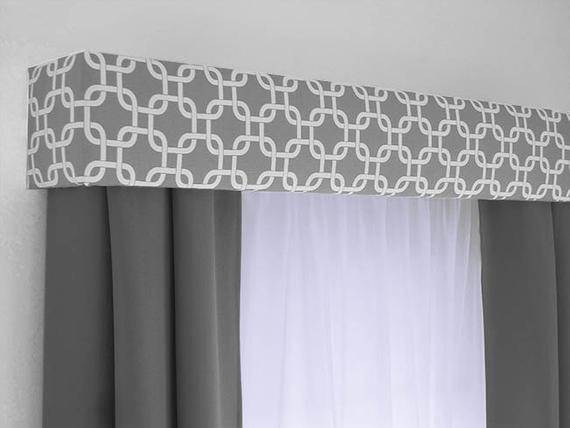Elegant-looking cornice boxes dress up rooms

Q: I was in a model home and saw some beautiful valance boxes above some windows. I found some similar ones, but they were horribly expensive. Anyway, I have decided to try making them myself. Can you give any hints on building these?
A: You are referring to cornice boxes, and they can really dress up a room. A cornice box is essentially a box with no bottom or back. The open side is mounted over the top of a window, door or over a window covering, for example, to cover a curtain rod.
The finished product is elegant looking. Cornice boxes can be covered with fabric, they can be stained and varnished, or they can simply be painted.
If you are going to cover the box in fabric, you can use ¾-inch plywood since nobody will see the wood anyway. If you plan on painting the box, you can use pine, which is cheaper, but you will have to fill in holes and knots to get a smooth surface. To avoid that step, use basswood or poplar instead.
If you plan on staining and varnishing you can use any hardwood, but you may have trouble finding trim molding in the same species. Oak is readily available, but if you plan on maple or cherry, you may have to hunt down molding at specialty lumber yards.
Start by measuring the dimensions for the box. Select a height and width, making sure that the inside dimensions will cover any curtain rods, and then measure for depth. To get the depth, hold the measuring tape against the wall and add an inch to the depth of the window coverings. You can play with the dimensions until you get the look you want.
Cornice boxes typically have crown molding along the top edge and various trim pieces along the bottom. For these cuts, you will use a power miter saw, preferably a sliding compound miter saw.
This tool can be rented for about $30. It allows you to cut two different angles simultaneously, and since the blade slides, you will be able to cut the height of the box with one motion.
If you will be staining and varnishing, use one long continuous piece of wood so that the grain will flow seamlessly around the corners of the box.
Cut the front and sides of the box at 45-degree angles using the miter saw. Spread a little glue on the mating surfaces and nail them together with 1-inch brads. (A brad nailer is great for this, but the rental yard will clip you for another $35.) A biscuit joiner is good for reinforcing the corners.
If you are using a hardwood, predrill the holes so that you don’t split the wood. Wipe off any excess glue with a damp cloth.
You don’t need to miter any cuts for the top of the box since it will be covered by crown molding. Cut the top piece and again spread a little glue on the surfaces and nail it all together so that the box is square.
Now you can decorate the box with the molding. This is where the cornice box goes from boring to inspiring. The crown molding can be whatever height you choose, but don’t use a profile so tall that it makes the box look top-heavy and out of proportion.
Cutting the crown molding is similar to cutting the mitered edges for the box. With a compound miter saw you can cut both angles at once.
If you are using a standard miter saw, you will need to turn the crown molding upside down and rest the edges on the fence and bed of the tool. Just mark a line on the molding so you can keep your cut oriented — it’s easy to get confused by turning the molding around.
Measure and cut the front piece of crown molding first, then do the sides. When the cuts are finished, glue it and nail it all together just like you did with the box. You can use cap trim or base shoe for the bottom front edge of the box, and you also can glue on various onlays.
Finish up by filling the holes with wood putty and then prime the box and paint it, or use stain and varnish.
To hang the box, draw a level line on the wall marking the point where the inside top of the box will rest. At this line, you can mount a 1-by-2-inch ledger board, or you can use several “L” brackets — just make sure you screw these items into the wall studs. Set the cornice box on top of the ledger board or “L” brackets.
If you are using the ledger board, screw the box to the board from the top of the box into the board. If you are using brackets, screw the brackets to the box from underneath.
The only problem you may run into is that the finished box may make your window coverings look so drab you may have to go buy new ones.
Mike Klimek is a licensed contractor and owner of Las Vegas Handyman. Questions may be sent by email to handymanoflasvegas@msn.com. Or, mail to 4710 W. Dewey Drive, No. 100, Las Vegas, NV 89118. His web address is www.handymanoflasvegas.com.
Do-it-yourself
Project: Cornice boxes
Cost: From about $50 per box
Time: 2-4 hours per box
Difficulty: ★★★★













